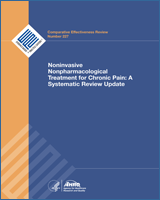From: Results

NCBI Bookshelf. A service of the National Library of Medicine, National Institutes of Health.
| Author, Year, Followup,a Pain Duration, Study Quality | Intervention | Population | Function and Pain Outcomes | Other Outcomes |
|---|---|---|---|---|
Lansinger, 2007221 6 and 12 months Pain duration: >5 years, 45% Poor | A. Qigong (n=72): 10-12 group sessions of 10-15 people done 1-2 times per week over 3 months. Sessions were 1 hour and consisted of information of the philosophy of medical qigong followed by exercises based on the Biyun method B. Exercise (n=67): 10-12 sessions 1-2 times per week over 3 months. Sessions were 1 hour and individualized to target 30%-70% of a person’s maximal voluntary capacity, with exercises aiming to maintain/increase circulation, endurance, and strength. All patients: Ergonomic instructions and a pamphlet containing written information on neck pain | A vs. B Age: 45 vs. 43 Female: 73% vs. 67% Physical activity: No to light exercise: 67% vs. 65% Med to hard exercise: 33% vs. 35% Baseline NDI (0-100), median: 26 vs. 22 Baseline pain (VAS, 0-10), median: 45 vs. 39 | A vs. B 6 months NDI, median: 22 vs. 18, p>0.05 Neck pain VAS (0-10), median: 2.6 vs. 2.3, p>0.05 12 months NDI, median: 22 vs. 18, p>0.05 Neck pain VAS, median: 2.8 vs. 2.1, p>0.05 | NR |
MacPherson, 2015213, Essex 2017214 ATLAS trial 1, 7, and 12 months Duration of pain, 7 years Fair [Essex – New publication reporting healthcare utilization] | A. Alexander Technique group (n=172): up to 20 one-to-one lessons of 30 minutes’ duration (600 minutes total) plus usual care, delivered weekly, with the option of being delivered twice per week initially and every 2 weeks later. B. Usual care (n=172) including general and neck pain–specific treatments routinely provided to primary care patients, such as prescribed medications and visits to physical therapists and other healthcare professionals. Treatment was 12 sessions over 5 months lasting 50 minutes. | A vs. B Age: 52 vs. 54 years Female: 69% vs. 69% White: 93% vs. 89% Employed: 61% vs. 62% P Baseline NPQ (0-100%): 39.6 vs. 40.5 | A vs. B 1 month NPQ: 35.4 vs. 40.9, difference −5.6 (95% CI −8.3 to −2.8) 7 months NPQ: 37.1 vs. 41.0, difference −3.9 (95% CI −6.9 to −1.0) | A vs. B 1 month SF-12v2 physical: data NR, p=NS SF-12v2 mental: data NR, p=NS 7 months SF-12v2 physical: 0.68 (95% CI −1.1 to 2.4), p=0.44 SF-12v2 mental: 1.76 (95% CI 0.2 to 3.4), p=0.033 12 monthsb Mean utilization of NHS resourcesc: p>0.05, data NR Mean utilization of private healthcare (additional sessions):
Mean total NHS cost (2012/13 UK £):1200 (95% CI 1000 to 1400) vs. 484 (95% CI 371 to 598), adjusted difference,d 667 (95% CI 472 to 896); p<0.001 |
Seferiadis, 2015222 3 months Pain duration: 9.5 years Fair | A. Basic body awareness therapy (n=57): 1.5 hour sessions twice a week for 10 weeks. Sessions consisted of exercises based on activities of daily living, meditation, and tai chi inspired exercises aiming to improve posture and increase efficient movement patterns B. Exercise (n=56): 1.5 hour sessions twice a week for 10 weeks. Sessions consisted of 45 minutes of muscle strengthening, 15 minutes of stretching, and 20 minutes of progressive muscle relaxation | A vs. B Age: 47 vs. 49 Female: 66% vs. 77% WAD classification: 1: 0% vs. 2% 2: 23% vs. 28% 3: 77% vs. 70% Baseline NDI (0-50): 20 vs. 18.8 | A vs. B 3 months NDI: Difference from baseline −2.0 (95% CI −3.5 to −0.5) vs. −1 (95% CI −2.5 to 0.4), p>0.05 | A vs. B 3 months SF-36v2 physical functioning (0-100): Difference from baseline 7.1 (95% CI 3.7 to 11.4) vs. 0.5 (95% CI −3.2 to 4.1), p>0.05 SF-36 role-physical(0-100): Difference from baseline 17.5 (95% CI 5.9 to 29) vs. 19 (95% CI 9.3 to 28.6), p>0.05 SF-36 bodily pain(0-100): Difference from baseline 12.2 (95% CI 6.9 to 17.6) vs. 4.9 (95% CI −0.1 to 9.8), p=0.044 SF-36 general health(0-100): Difference from baseline 7.5 (95% CI 2.4 to 12.6) vs. 4.5 (95% CI −0.1 to 9), p>0.05 SF-36 vitality(0-100): Difference from baseline 7.3 (95% CI 1.0 to13.6) vs. 5.6 (95% CI −0.5 to 11.6), p>0.05 SF-36 social functioning(0-100): Difference from baseline 13.3 (95% CI 6.6 to 19.9 vs. 3.5 (95% CI −3 to 9.9), p=0.037 SF-36 role-emotional (0-100): Difference from baseline 9.3 (95% CI −2.3 to 21) vs. 4 (95% CI −8.3 to 16.4), p>0.05 SF-36 mental health (0-100): Difference from baseline 2.8 (95% CI −2 to 7.6) vs. 1.2 (95% CI −3.6 to 5.9), p>0.05 |
CI = confidence interval; NDI = Neck Disability Index; NHS = National Health Service; NPQ = Northwick Park Neck Pain Questionnaire; NR = not reported; SF-12 = Short-Form 12 Questionaire; SF-36 =Short-Form 36 Questionnaire; UK = United Kingdom; VAS = visual analog scale; WAD = Whiplash Associated Disorders
Unless otherwise noted, followup time is calculated from the end of the treatment period.
12 month data are health utilization data only from a subset of patients from the ATLAS trial (publication Essex 2017) who had full economic data N=293 (57%) [to include the acupuncture arm; details in the Acupuncture section]; no demographic data provided for the subset
Across all appointment types and prescription medications; National Health Services (NHS) appointment types to include, general practitioner appointments, physiotherapy visits, hospital outpatient visits, accident and emergency admissions, hospital day case admissions, other hospital admissions. NHS prescription medication included all prescription medication and prescription items specifically for neck pain. Neck pain prescriptions t-test comparing usual care and acupuncture borderline significance (p=0.06).
For baseline NHS healthcare costs and practice size.
From: Results

NCBI Bookshelf. A service of the National Library of Medicine, National Institutes of Health.